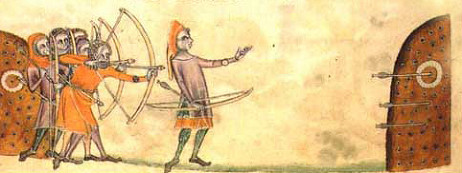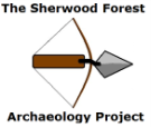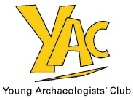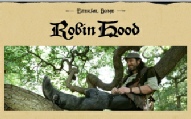Sport and the Forest are intrinsically linked.
The official declared purpose for a forest after all was for hunting the beasts of the chase.
Alongside this kingly pursuit, lords and landowners often enjoyed the privilege to hunt the beasts of the warren-
Especially popular with the upper classes was hunting with the hawk, and an entire courtly etiquette built up around this sport with certain birds being limited in their use to only certain levels of society (more soon).
These sports left their mark on Medieval Sherwood Forest through the presence of the great royal deer parks of Clipstone, Bestwood and the Castle Park.
Also through such landscape features as the ‘King’s stands’: areas where the king would wait and shoot arrows from, when deer were driven past.
A site near Gleadthorpe in the north of the forest was known as ‘Kyngges Trist’ in the early 15th century (Belvoir map).
As well as these forest sports there were many common medieval sports played by everyday people in the English countryside.

Picture: Medieval Archery
Archery was the mot popular sport-
This sport was even more popular following the banning of many others in its favour...
One of these was described as ‘abominable… more common, undignified and worthless than any other game, rarely ending but with some loss, accident or disadvantage to the players themselves’ (Coulton 1940).
...Football of course!
It was played by teams sometimes numbering hundreds on pitches sometimes miles long. It would be easy to see games being played on the wide expanses of the heaths and commons of the forest, with people falling into gorse bushes and rolling in the heather and brambles.
Football was played in Nottingham in the Medieval period (Foulds in Beckett 2006), and luckily there were 'bonesetters' in the town to deal with the casualties!
It survives in this form in the Shrove Tuesday matches played in nearby Ashbourne.
Ian Mortimer in his Time travellers guide to the 14th century (2008) suggests that the only rules associated with football at the time were those banning it!
This blood thirsty and violent sport was repeatedly banned in the 14th century.
It seems a surprise that football was considered so barbarous, when it is viewed alongside some of the other popular sports of the day.
Bear and bull bating were immensely popular along with dog fights and cock fighting. A bear may have been kept in Nottingham, as John Draper held the position of Bearward in 1433 (Foulds, in Beckett 2006). There is also a Bearward Street recorded on the 1610 map of Nottingham by John Speed.
All are shocking to us now-
The 1609 crown survey map of Sherwood Forest shows a circular cock pit for crowds to watch cock-
This suggests official backing as such a site could hardly be deemed an underground venue, located as it was on the Kings own manor of Arnold. Interestingly it is now under a modern day a golf course…
Picture: Exerpt from the 1609 Crown Survey of Sherwood Forest by Richard bankes. (Mastoris and Groves 1998).
The Major Oak in the Sherwood Forest National Nature Reserve (believed to be 1,000 years old and the hideaway of Robin Hood) was itself at one time known as the 'Cock-
The poem about the hero Gamelyn dating from the 14th century tells of a wrestling match-
The Bishop of Rochester suggested wrestling belonged in the same category as glutony, and chatting idly in the market, and anything else that distracted the populace from listening to the sermons' (Mortimer 2008).
Obviously gambling played a major part in contests between animals, and those between people. As well as this people played dice, quoits, cards, and horse racing.
Along side bloodsports, fighting, gambling (and football) people also enjoyed stick and ball games and even 'real tennis'.
According to Mortimer tennis would take place when a net was strung across the street-
In the forest itself the 1609 Crown Survey Map also shows an outdoor bowling alley on the Mount Hooton Escarpment roughly on the line of modern day 'Forest Road' overlooking the Nottingham Lings to the north and Nottingham town to the south. Doubtless bowls was in some way more violent than nowadays too!
The Medieval period was an age of contrasts; and as well as enjoying bouts of extreme violence people listened to plays, songs, music and poems, they loved dancing and they watched acrobats and mummers.
One of the favourite pastimes was listening to ballads of heroes and legends... many of who will be discussed soon including the outlaws Adam Bell, Clim of the Clough, Fulk Fitzwarin, Eustace the Monk, the hero Gamelyn, Hereward the Wake, and of course others including Robin Hood himself.
These heroes and outlaws, and their actions help us to see what fired peoples imaginations. They show us the values of the common man at the time in ways that the laws and etiquettes of the social elite never can.
In the same way the games, sports and pastimes of ordinary people help to give us a glimpse into their lives and concerns.
The actions and day to day lives of the ordinary people in Medieval Sherwood Forest are what help to bring the place back to life.
(Andy Gaunt, first published 15/11/2011)
Click here for more ‘Stories from the Forest’…



Community Archaeology Nottinghamshire, Community Archaeology Derbyshire, Community Archaeology Leicestershire, Community Archaeology East Midlands, Mercian Archaeological Services Community Archaeology for Nottinghamshire, Derbyshire, Sherwood Forest, Leicestershire and the East Midlands. Community Archaeology Nottinghamshire, Community Archaeology East Midlands, Community Archaeology Leicestershire. Archaeological

Medieval sports and pastimes in the Forest
Award Winners 2016
for "Engaging people in the heritage, history & archaeology of Sherwood Forest".





Some funders and partners:
World-











Mercian Archaeological Services CIC
Specialists in Community Archaeology, Public Involvement, Research & Training
Community Archaeology Nottinghamshire, Excavation, Research, Volunteering, Community Archaeology Derbyshire, Training, Social, Learning, Community Archaeology Leicestershire, Heritage, Involvement, Belonging, Knowledge sharing, Community Archaeology Lincolnshire, Topographic Survey, Talks and Presentations, Outreach, Archaeology Projects , Open Days, Schools, Finds Processing, Day Schools, Field Schools, Young People, Archaeology and History of Sherwood Forest, Pottery Research, Medieval, Roman, Prehistoric, Community Interest Company, Community Archaeology Nottinghamshire.
Community Archaeology in Nottinghamshire
Community Archaeology in Derbyshire
Community Archaeology in Leicestershire
Community Archaeology East Midlands
Community Archaeology in Lincolnshire
© Mercian Archaeological Services CIC 2013. Registered Business No. 08347842. All Rights Reserved.
The Future of Sherwood’s Past
Project page links:
-
-
-
-
-
-
-
-
The Sherwood Forest
National Nature Reserve Archaeology Survey
-
Long term Research at
King John’s Palace:
Ancient Royal Heart of Sherwood Forest
-
The Sherwood Forest Archaeology Training Fieldschool
-
“Scirwuda-
Ghost and Shadow woods of Sherwood Forest Project
-
Investigating Thynghowe Viking
Meeting Site
-
Searching for the
The Battle of Hatfield
-
-
Fieldswork at St Edwin’s Chapel
-
St Mary’s Norton-
-
Mapping Medieval Sherwood Forest
-
The Sherwood Forest LiDAR
Project
-
Warsop Old Hall
Archaeological Project
-
The Sherwood Villages Project:
Settlement Development in the Forest
-
-
-
Researching Edward IIs fortification at Clipstone Peel
-
-
-
-
The Cistercians of Rufford Project:
Settlement Development, Dynamics and Desertion.
-
Sherwood Forest Environmental Survey
-
World War II in Sherwood Forest -
-
World War I in Sherwood Forest -
-
About Medieval Sherwood Forest
-
Robin Hood and Sherwood Forest
-
-
-
-
-
-
-
-
-
-
-
-
Project page links:
-
-
-
-
-
-
-
-
The Sherwood Forest
National Nature Reserve Archaeology Survey
-
Long term Research at
King John’s Palace:
Ancient Royal Heart of Sherwood Forest
-
The Sherwood Forest Archaeology Training Fieldschool
-
“Scirwuda-
Ghost and Shadow woods of Sherwood Forest Project
-
Investigating Thynghowe Viking
Meeting Site
-
Searching for the
The Battle of Hatfield
-
-
Fieldswork at St Edwin’s Chapel
-
St Mary’s Norton-
-
Mapping Medieval Sherwood Forest
-
The Sherwood Forest LiDAR
Project
-
Warsop Old Hall
Archaeological Project
-
The Sherwood Villages Project:
Settlement Development in the Forest
-
-
-
Researching Edward IIs fortification at Clipstone Peel
-
-
-
-
The Cistercians of Rufford Project:
Settlement Development, Dynamics and Desertion.
-
Sherwood Forest Environmental Survey
-
World War II in Sherwood Forest -
-
World War I in Sherwood Forest -
-
About Medieval Sherwood Forest
-
Robin Hood and Sherwood Forest
-
-
-
-
-
-
-
-
-
-
-
-